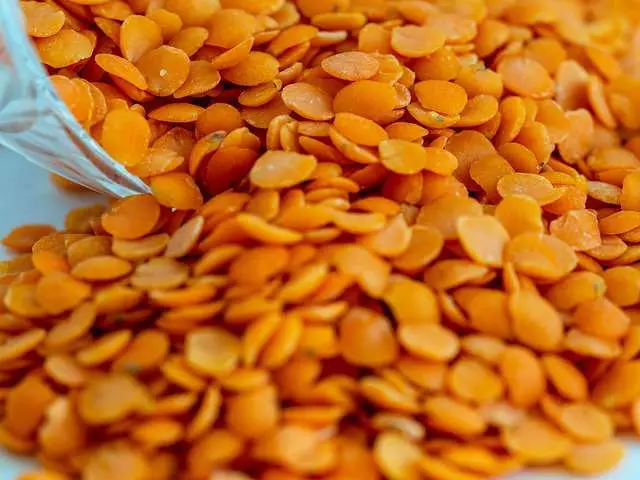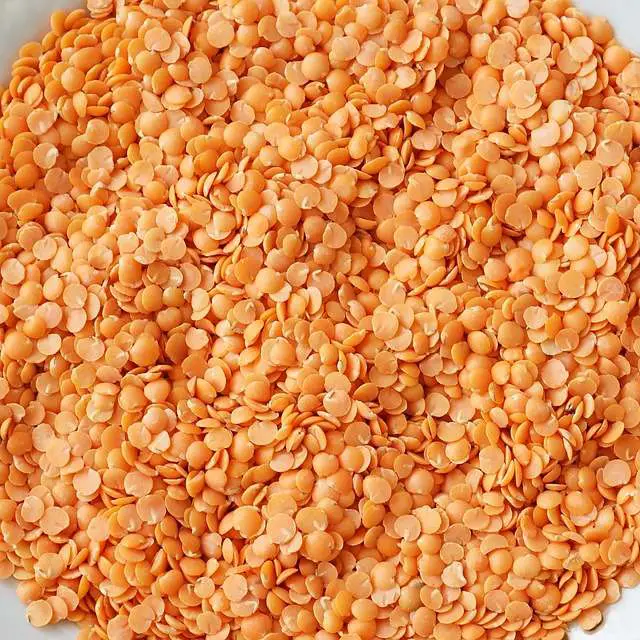Introduction:
Red lentils are a type of edible legume known scientifically as Lens culinaris. Despite having a color range from light pink to a deep orange, they are known as “red” lentils because of their characteristic reddish-orange color.
A common ingredient in many different cuisines around the world, the nutrition facts of red lentils are particularly popular in Indian, Middle Eastern, and Mediterranean cookery. As previously indicated, red lentils are often tiny, lens-shaped, and have a striking reddish-orange color.

However, cooking may cause some color fading. When cooked, red lentils have a delicate, creamy texture and a moderate flavor. They usually disintegrate quickly, making them ideal for foods like purees, stews, and soups.
Nutrition Facts of Red Lentils:
Let’s examine the red lentil’s nutrition facts of red lentils, taking into account the essential components you mentioned:
Serving size and caloric content
Calories: Red lentils have a low-calorie count. Red lentils that have been cooked contain roughly 230–250 calories per cup (or 200g).
However, it could change a little based on the added ingredients and cooking techniques.
Carbohydrates
Carbohydrates, which account for the majority of the calories in red lentils, are their principal macronutrient.
About 40–45 grams of carbs are typically present in a cup serving. Starch and dietary fiber are two examples of these carbs.
Protein
Red lentils are a great plant-based source of protein. They are an excellent source of protein for vegetarians and vegans because a cup portion normally has 15–18 grams of protein.
Dietary fiber
Red lentils also contain a lot of this substance, which is good for digestion and encourages a sensation of satiety. Typically, a cup of food has 15–16 grams of dietary fiber.
Vitamin B
Red lentils are a good source of several B vitamins, including niacin (vitamin B3), folate (vitamin B9), thiamine (vitamin B1), riboflavin (vitamin B2), and folate (vitamin B9). Folate is particularly interesting due to its significance during pregnancy and its role in cell division.
Vitamin C
Red lentils include small amounts of this vitamin, which is crucial for its involvement in immune function and collagen creation even though they are not particularly high in it compared to some other foods. for being.
Iron
Red lentils are a good source of iron, which is necessary for the blood’s oxygen transport system and the creation of overall energy. Usually, one cup of food contains 6-7 milligrams of iron.
Potassium
An electrolyte that aids in controlling blood pressure, fluid balance, muscle, and nerve function, these lentils are a good source of potassium.
Magnesium
Magnesium is present in red lentils and necessary for the health of bones, muscles, and nerves as well as the metabolism of energy.
Zinc
Red lentils also contain zinc, which is necessary for DNA synthesis, wound repair, and immunological function.
Health Benefits of Red Lentils:
Here are nutrition facts about red lentils and five advantages for your health of using red lentils in your diet:
1. Heart health
Red lentils are a nutritious food for the heart. They have low levels of cholesterol and saturated fat, both of which raise the risk of heart disease.
Their high dietary fiber content can assist cardiovascular health by lowering blood levels of LDL (bad) cholesterol. Red lentils’ potassium content aids in blood pressure regulation, which is also good for the heart.

2. Weight Management
Due to their high protein and fiber content, red lentils are an important part of diets for weight management.
Red lentils’ high fiber content adds bulk to meals, promoting feelings of satiety and perhaps lowering calorie intake. Protein aids in promoting feelings of fullness and can help regulate hunger.
3. Blood Sugar Control
Red lentils have a low glycemic index (GI), which means they raise blood sugar levels gradually and steadily rather than abruptly.
They are a great option for those who have diabetes or are at risk for developing it since the combination of fiber and complex carbs in them helps to normalize blood sugar levels.
4. Nutrient Density
Red lentils are nutrient-dense foods, which means they have a high concentration of important nutrients compared to their caloric content.
They are a good source of vitamins and minerals like folate, iron, potassium, magnesium, and zinc, all of which are crucial for maintaining overall health and wellness.
5. Digestive Health
Red lentils’ dietary fiber helps to maintain digestive health by encouraging regular bowel movements and averting constipation.
Better gut health and immunity can be attributed to fiber’s prebiotic role in nurturing good gut flora, which can also have a positive effect on immunity.
Better digestion can also lead to better nutrition and general wellness.
How to incorporate Red Lentils into your diet:
Red lentils are simple and adaptable to include in your diet. To add taste, texture, and nutrients to a variety of foods, they can be employed. Additional ways to incorporate red lentils into your diet are listed below:

Red lentil sauce for pasta
Red lentils, which naturally thicken sauces and add protein and fiber to pasta recipes, can be cleaned and combined with your preferred pasta sauce.
Red Lentil Burgers or Patties
Combine cooked red lentils with breadcrumbs, spices, and finely chopped veggies to create a vegetarian or vegan burger. Create patties from the mixture, cook them in a pan, or bake them in the oven.
Red Lentil Hummus
By combining red lentils with chickpeas, tahini, lemon juice, garlic, and spices, you can give conventional hummus a distinctive touch. This variant gives your dip a gorgeous color and is high in protein.
Red Lentil Breakfast Porridge
Cook red lentils until they are fork-tender, then combine them with spices, milk (dairy or plant-based), and sugar. As a hot breakfast cereal, combine with yogurt, fruit, and nuts.
Red Lentil Dips
To make a tasty dip, combine cooked red lentils with roasted red peppers, garlic, lemon juice, and olive oil.
FAQs:
1. Are brown or green lentils the same as red lentils?
Red lentils, a unique kind distinguished by their vivid reddish-orange color and speedy cooking time, are not.
2. Do red lentils need to be soaked before cooking?
Red lentils don’t require soaking, so no. They can be immediately cooked after rinsing.
3. Do red lentils include a good amount of protein?
Yes, red lentils contain roughly 15 to 18 grams of plant-based protein per cooked cup.
4. How long do red lentils take to cook?
Red lentils are one of the forms of lentils that cook the quickest, typically taking between 15 and 20 minutes.
5. Are red lentils suitable for salads?
To add texture and nutrients to salads, red lentils should be cooked and cooled before use.
Conclusion:
Red lentils are a diverse and healthy supplement to your diet, to sum up. They help heart health, weight loss, blood sugar regulation, and digestive health, among other aspects of good health.
Red lentils are a great element in several cuisines, from soups and curries to salads and dips, due to their high protein, fiber, vitamins, and mineral content. Red lentils can be a tasty and healthy addition to your diet, regardless of whether you’re a vegetarian, vegan, or just trying to better your diet in general.
They can be a simple and delectable addition to a range of culinary masterpieces due to their rapid cooking time and versatility.
